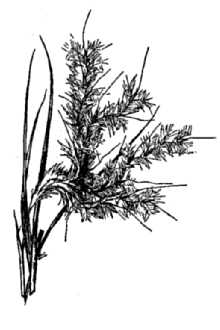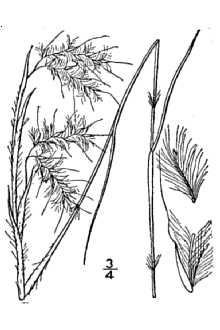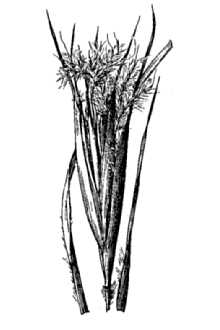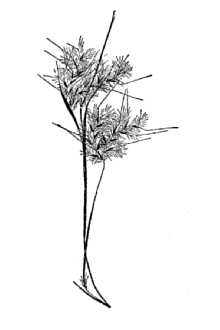Elliott's Bluestem
Scientific Name: Andropogon gyrans Ashe var. gyrans

| General Information | |
|---|---|
| Usda Symbol | ANGYG |
| Group | Monocot |
| Life Cycle | Perennial |
| Growth Habits | Graminoid |
| Native Locations | ANGYG |
Plant Guide
Alternate Names
Andropogon campyloracheus, Andropogon elliottii, Andropogon elliottii var. gracilior, Andropogon elliottii var. projectus, Andropogon subtenuis.
Uses
Elliott’s bluestem is grazed readily by cattle during spring and early summer. Forage quality is relatively high when green. Protein concentrate should be provided when grazed during dormant season.
Status
Please consult the PLANTS Web site and your State Department of Natural Resources for this plant’s current status, such as, state noxious status and wetland indicator values.
Description
Elliott’s bluestem is a warm-season, perennial bunch grass, The height is usually 2-1/2 to 3 feet, The leaf blade is 6 to 15 inches long, smooth except for cluster of hair just above ligule, The leaf sheath is a basal sheath that is keeled, overlapping, relatively narrow; and has rounded upper sheaths, The stem is erect; 1 to 6 per plant, branching near top, The seedhead is a raceme, partially enclosed in conspicuous enlarged spathe, which turns a rusty color when plant matures, Line drawing reprinted from Hitchcock, A,S, 1950, Manual of the grasses of the United States, USDA Misc, Pub, Use soil moisture sensors to measure the soil moisture of Elliott's Bluestem., No, 200, U,S, Gov, Printing Office, Washington, D,C,
Management
Although of fair grazing value, this grass is seldom, if ever, abundant enough to be a key management species. It usually makes up no more than 3 to 5 percent of the plant composition. Proper grazing of more plentiful associated grasses maintains proper percentage of this grass in the plant community.
Establishment
New growth starts in early spring but most of growth is made during spring and summer. Seedheads develop during fall, and seedstalks remain for several months. Distinctive seedhead clusters make plants conspicuous after maturity. Grows best in open areas but tolerates some shade. Adapts primarily to well-drained soils on uplands and does not tolerate wet sites. Cultivars, Improved and Selected Materials (and area of origin) Please contact your local NRCS Field Office.
References
Frandsen, W. 1960. Grass makes its own food. United States Department of Agriculture Information Bulletin. 223 pp. Gates, F. 1937. Grasses in Kansas. Kansas State Bd. Agriculture Report. 220-A. 55: Pp. 349. Gay, C. & D. Dwyer 1965. New Mexico grasses. New Mexico State University. Circ. 374. 85 pp. Hitchcock, A. 1950. Manual of the grasses of the United States. 2nd Ed. Revised by Agnes Chase. United States Department of Agriculture Misc. Pub. 200. 1051 pp. Hoffman, G. & B. Ragsdale [n.d.]. Know your grasses. Texas A & M University Agriculture Extension Service Bulletin. 182 (Rev.). 48 pp. Judd, I. 1962. Principal forage plants of southwestern ranges. United States Department of Agriculture Forest Service. Leithead, H.L, L.L. Yarlett, & T.N. Shiflet. February 1971. 100 native forage grasses in 11 southern states. USDA SCS Agriculture Handbook No. 389, Washington, D.C. 216p. Rechenthin, C. A. 1956. Elementary morphology of grass growth and how it affects utilization. J.



